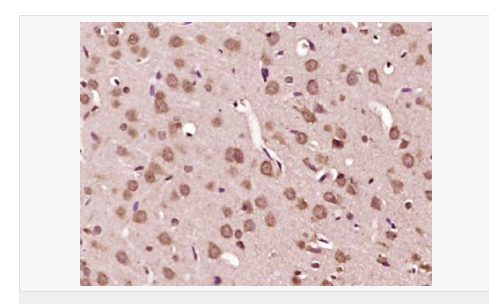

貨號
產品規(guī)格
售價
備注
BN41904R-50ul
50ul
¥1486.00
交叉反應:Human,Rat,GuineaPig(predicted:Mouse,Chicken,Dog,Pig,Cow,Sheep) 推薦應用:IHC-P,IHC-F,IF,Flow-Cyt,ELISA
BN41904R-100ul
100ul
¥2360.00
交叉反應:Human,Rat,GuineaPig(predicted:Mouse,Chicken,Dog,Pig,Cow,Sheep) 推薦應用:IHC-P,IHC-F,IF,Flow-Cyt,ELISA
BN41904R-200ul
200ul
¥3490.00
交叉反應:Human,Rat,GuineaPig(predicted:Mouse,Chicken,Dog,Pig,Cow,Sheep) 推薦應用:IHC-P,IHC-F,IF,Flow-Cyt,ELISA
產品描述
| 英文名稱 | VEGF-A |
| 中文名稱 | 血管內皮生長因子A |
| 別 名 | Vascuoar endothelial growth factor A; VEGF A; vascular endothelial growth factor A isoform 2 precursor; Vegf; VEGFA; MGC70609; MVCD1; VEGF; VPF; VEGFA_HUMAN; Vascular endothelial growth factor A; VEGF-A; Vascular permeability factor; VPF; VEGF A Precursor. |
| 研究領域 | 腫瘤 細胞生物 免疫學 生長因子和激素 血管內皮細胞 |
| 抗體來源 | Rabbit |
| 克隆類型 | Polyclonal |
| 交叉反應 | Rat, (predicted: Human, Mouse, Chicken, Dog, Pig, Cow, Sheep, Guinea Pig, ) |
| 產品應用 | ELISA=1:5000-10000 IHC-P=1:100-500 IHC-F=1:100-500 IF=1:100-500 (石蠟切片需做抗原修復) not yet tested in other applications. optimal dilutions/concentrations should be determined by the end user. |
| 分 子 量 | 24kDa |
| 細胞定位 | 細胞外基質 分泌型蛋白 |
| 性 狀 | Liquid |
| 濃 度 | 1mg/ml |
| 免 疫 原 | KLH conjugated synthetic peptide derived from human VEGF-A:141-180/191 |
| 亞 型 | IgG |
| 純化方法 | affinity purified by Protein A |
| 儲 存 液 | 0.01M TBS(pH7.4) with 1% BSA, 0.03% Proclin300 and 50% Glycerol. |
| 保存條件 | Shipped at 4℃. Store at -20 °C for one year. Avoid repeated freeze/thaw cycles. |
| PubMed | PubMed |
| 產品介紹 | This gene is a member of the PDGF/VEGF growth factor family and encodes a protein that is often found as a disulfide linked homodimer. This protein is a glycosylated mitogen that specifically acts on endothelial cells and has various effects, including mediating increased vascular permeability, inducing angiogenesis, vasculogenesis and endothelial cell growth, promoting cell migration, and inhibiting apoptosis. Elevated levels of this protein is linked to POEMS syndrome, also known as Crow-Fukase syndrome. Mutations in this gene have been associated with proliferative and nonproliferative diabetic retinopathy. Alternatively spliced transcript variants, encoding either freely secreted or cell-associated isoforms, have been characterized. There is also evidence for the use of non-AUG (CUG) translation initiation sites upstream of, and in-frame with the first AUG, leading to additional isoforms. Function: Growth factor active in angiogenesis, vasculogenesis and endothelial cell growth. Induces endothelial cell proliferation, promotes cell migration, inhibits apoptosis and induces permeabilization of blood vessels. Binds to the FLT1/VEGFR1 and KDR/VEGFR2 receptors, heparan sulfate and heparin. NRP1/Neuropilin-1 binds isoforms VEGF-165 and VEGF-145. Isoform VEGF165B binds to KDR but does not activate downstream signaling pathways, does not activate angiogenesis and inhibits tumor growth. Subunit: Homodimer; disulfide-linked. Also found as heterodimer with PGF Subcellular Location: Secreted. Note=VEGF121 is acidic and freely secreted. VEGF165 is more basic, has heparin-binding properties and, although a signicant proportion remains cell-associated, most is freely secreted. VEGF189 is very basic, it is cell-associated after secretion and is bound avidly by heparin and the extracellular matrix, although it may be released as a soluble form by heparin, heparinase or plasmin. Tissue Specificity: Isoform VEGF189, isoform VEGF165 and isoform VEGF121 are widely expressed. Isoform VEGF206 and isoform VEGF145 are not widely expressed. DISEASE: Defects in VEGFA are a cause of susceptibility to microvascular complications of diabetes type 1 (MVCD1) [MIM:603933]. These are pathological conditions that develop in numerous tissues and organs as a consequence of diabetes mellitus. They include diabetic retinopathy, diabetic nephropathy leading to end-stage renal disease, and diabetic neuropathy. Diabetic retinopathy remains the major cause of new-onset blindness among diabetic adults. It is characterized by vascular permeability and increased tissue ischemia and angiogenesis. Similarity: Belongs to the PDGF/VEGF growth factor family. SWISS: P15692 Gene ID: 7422 Database links: Entrez Gene: 7422 Human Entrez Gene: 22339 Mouse Omim: 192240 Human SwissProt: P15692 Human SwissProt: Q00731 Mouse Unigene: 73793 Human Unigene: 282184 Mouse Unigene: 1923 Rat Important Note: This product as supplied is intended for research use only, not for use in human, therapeutic or diagnostic applications |

